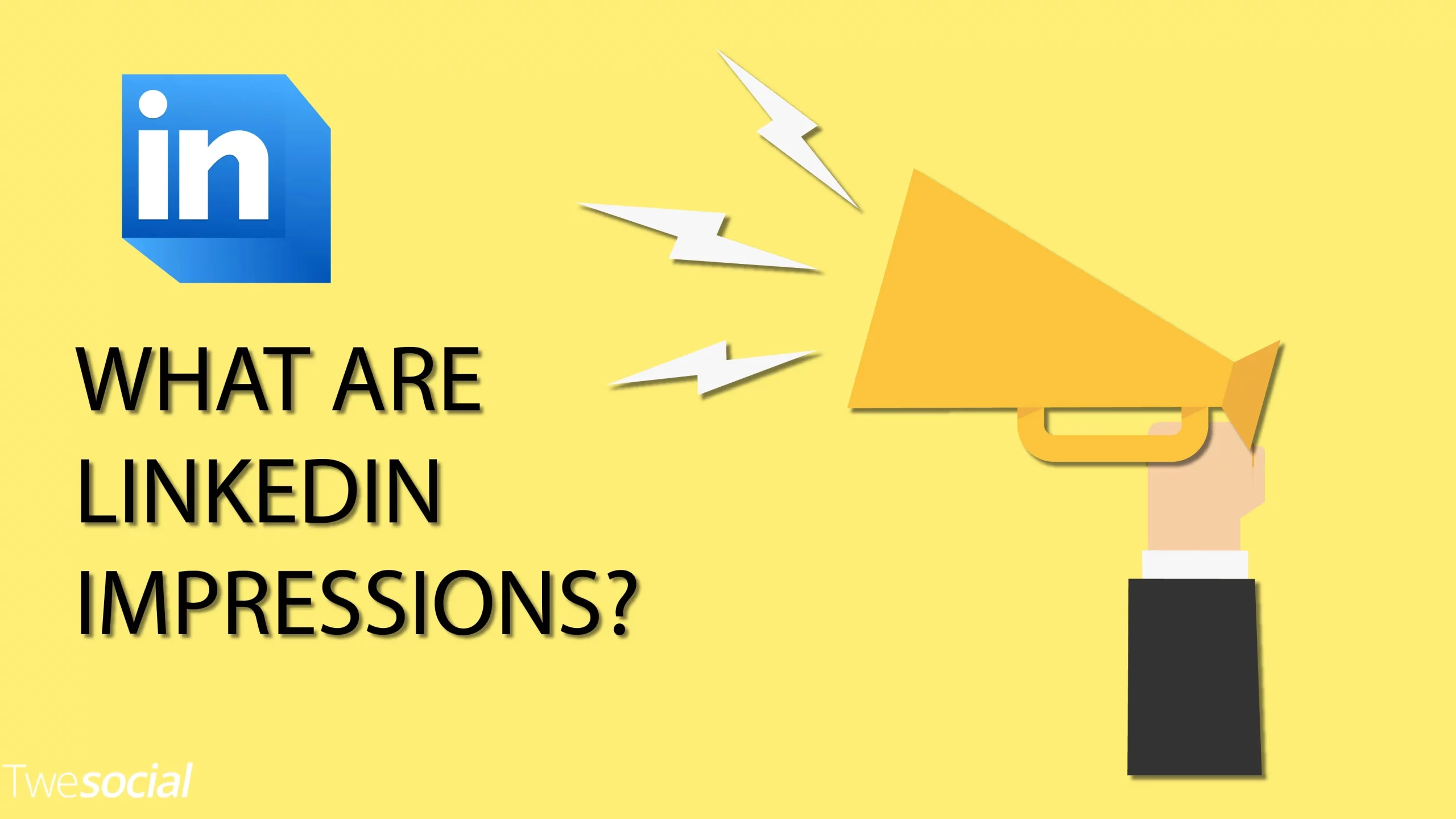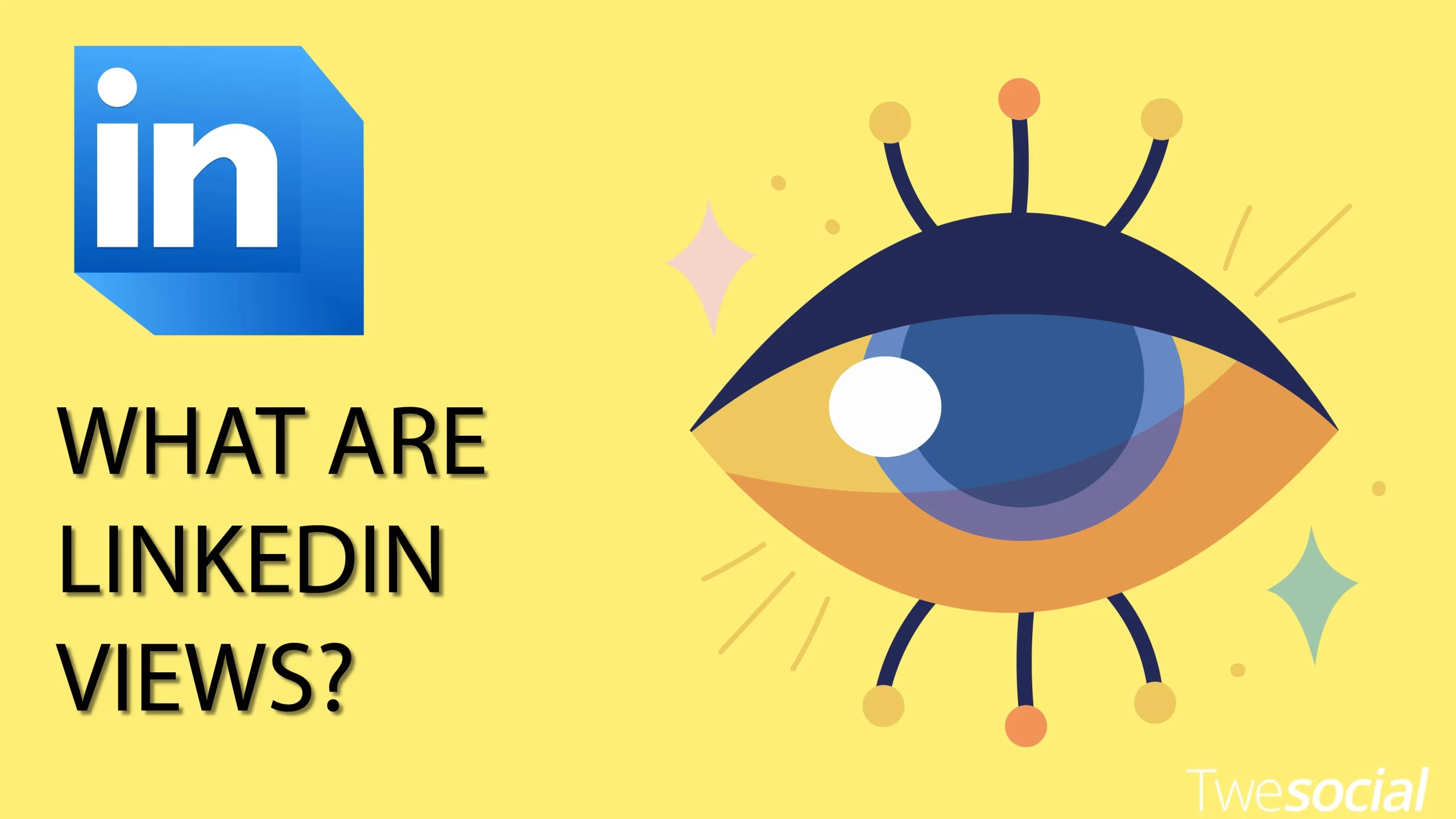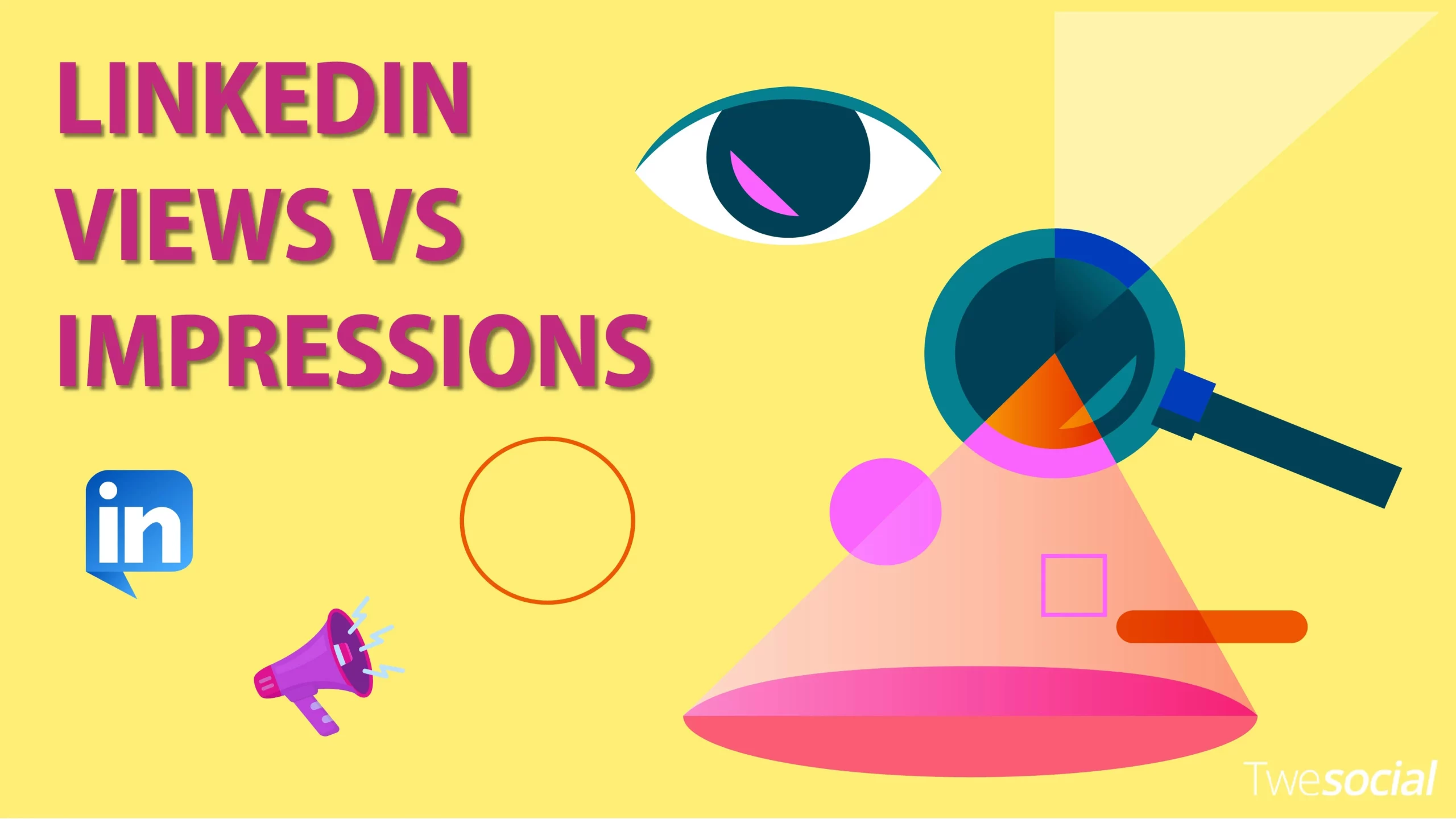When it comes to optimising your LinkedIn presence, you need to understand the difference between LinkedIn views vs impressions. Are views more important or are impressions? We all struggle with this as we build our personal brand on the platform.
In this post, you’ll learn the difference between LinkedIn views and impressions, why they matter, and how to effectively use both to enhance your content’s reach and engagement on the platform.
What are LinkedIn Impressions?

LinkedIn impressions are the number of times your content is shown on someone’s screen, whether they interact with it or not. Unlike views, impressions don’t require the user to click on your content, they just need to scroll past it in their LinkedIn feed for it to count.
Why LinkedIn Impressions Matter for Your LinkedIn Posts
Broad Reach: Impressions are a great way to measure the potential reach of your content. A high number of impressions means your content is being seen by a wide audience even if they’re not engaging with it directly. Good for brand awareness and keeping your content top of mind for LinkedIn users.
Content Strategy: Impressions can help you refine your content strategy by showing you how often your content is being shown. For example, if your posts are getting a lot of impressions but few views, it’s time to evaluate the content quality or the relevance of your posts. Understanding this can help you adjust your strategy to post more engaging and quality content that not only reaches but also engages your audience.
Misconceptions: While a high number of impressions might seem like a good thing, it can sometimes create a false sense of success. Impressions alone don’t necessarily mean meaningful connections or engagement. You need to look beyond the impression count and see if your content is truly resonating with your audience.
LinkedIn Views vs Impressions: A Breakdown
When it comes to understanding your LinkedIn performance, it’s easy to get caught up in the numbers. But not all metrics are created equal. Views and impressions each tell a different story about how your content is performing. Let’s break down what these numbers really mean and why they matter for your LinkedIn strategy.
Views vs Impressions: Which One Tells the Truth?
When comparing LinkedIn views vs impressions, you need to know that neither tells the whole story. Impressions show you how often your content is being seen, views show you how engaging that content is. If you’re only looking at impressions you might miss out on whether your content is actually grabbing your audience’s attention.
Why Views Are Better Than Impressions
While both views and impressions are important metrics, views have more tangible benefits. Here’s a quick rundown why views are better:
- Direct Engagement: Views mean someone has taken the time to actively engage with your content, they’re interested in what you have to say.
- Stronger Personal Brand: More views = stronger personal brand, they show the actual reach and impact of your content.
- Better Content Feedback: Views give you clearer feedback on what content resonates with your audience, so you can refine your content strategy better.
- More Opportunities: More views = more connections, opportunities to network and business collaborations.
In short, while impressions show how often your content is seen, views show how often it’s valued; so views are a more powerful metric for growing your LinkedIn profile.
The Balance Between Views and Impressions
The secret to a successful LinkedIn strategy is finding the balance between views and impressions. High impressions with fewer views mean your content is visible but not engaging.
High views with moderate impressions mean your content is engaging but not visible enough. By looking at both metrics together you can see content impact and refine your strategy to get the best of both worlds.
What are LinkedIn Views?

LinkedIn views are a direct measure of how many times your content (post, video, article) has been actively engaged with by others. This means someone has clicked on your content and taken the time to view it. This is more than just a quick glance on someone’s screen; it’s a deliberate action, showing real interest in what you have to say.
Why LinkedIn Views Matter
Personal Brand: LinkedIn views are part of building your personal reputation. When people view your content, they’re interested in what you’re sharing, which can lead to more followers, connections and even professional opportunities. The more views you get, the more credibility you build with your audience.
Content Engagement: High view counts can be a good indicator of content quality engagement. It means your content is resonating with your audience’s interests which is key to building meaningful connections. For example if you notice a certain type of content consistently gets high views, that’s a sign your audience finds it valuable and you should create more of that content.
Real-Life Example: Post an article and get a lot of views. Not only does that increase your visibility but it also increases the chances of others sharing your content and extending your reach. That kind of engagement turns casual viewers into followers and connections and strengthens your LinkedIn profile.
Boost Your LinkedIn with TweSocial
Looking to increase your LinkedIn views? TweSocial is the way to do it. We’ve helped hundreds of clients and it’s not just about numbers, it’s about giving your content the attention it deserves. If you want to boost your individual reputation or drive more engagement, buying LinkedIn views through TweSocial can make a big difference.
It’s easy and hassle free. Just provide a link to your content, choose your package, and pay. We even accept cryptocurrency payments. Beyond views, TweSocial offers full range of social media engagement services including followers, likes, and reactions all customizable to your goals. And if you need help, our 24/7 customer support team is here to assist you through live chat or email to make it smooth and easy.
How to Get Both Views and Impressions
If you want your LinkedIn content to truly shine, it’s important to focus on getting both views and impressions. While impressions get your content in front of more people, views show that your content is actually engaging and valuable.
Whether you’re looking to boost your post views, video views, or article views, finding the right balance between views and impression count will help you maximize your impact on the platform.
High-Quality Content to Target Audience
The base of increasing both views and impressions is a quality content. This means knowing your audience and tailoring your content to them. For example, if your audience is professionals in the tech industry your content should be about topics that are relevant to them.
High-quality content gets more views because it resonates with your audience and that engagement gets more impressions as LinkedIn’s algorithm pushes it to a diverse audience.
LinkedIn Insights
Using LinkedIn Insights is a great way to track your views and impressions. Check your insights regularly to see what’s working and what’s not. For example, if you see your video views are higher than your post views you may want to create more video content. LinkedIn Insights gives you the tools to optimize your content.
Post Regularly to Grow
Consistency is everything when it comes to growing your views and impressions on LinkedIn. Posting regularly keeps you top of mind in your audience’s LinkedIn feed, and keeps you visible. Whether it’s sharing articles, videos or posts, the more you post valuable content the more they will engage with it.
This will not only boost your current numbers but also build you a loyal following over time and increase your reach and impact on the platform.
Personal Branding in Views and Impressions

On LinkedIn building a strong personal image is key to getting views and impressions. An individual reputation makes your content more recognizable and trustworthy so others will engage with it.
When we focus on our individual reputation we’re not just after visibility we’re creating a story that resonates with our audience. This connection can lead to a huge increase in views and impressions as people will engage with content that’s relevant to them and their values.
Engagement Rate and Personal Brand
Your engagement rate is linked to your individual reputation. If you have a strong individual reputation your content will generate more meaningful connections which in turn will boost your engagement rating.
For example, a well-written post that reflects your expertise and personality will get shared, commented on, and liked more, thereby generating more views and impressions. This engagement will not only increase your reach but also accurately reflect content impact, enhancing your personal reputation and creating a positive feedback loop.
Common Mistakes to Avoid
One mistake we see is we focus too much on the number of impressions without considering the quality of engagement. We get caught up in the high impression numbers and assume our content is working. But impressions alone can be deceiving.
If your content isn’t getting views or engagement those impressions are just numbers on a screen. This overemphasis can lead to focusing on the wrong things like pushing content to a bigger audience without making sure it resonates with them.
Ignoring Content Engagement
Another mistake is ignoring content engagement for the sake of more impressions. While we need to reach a wider audience we need to make sure the content we’re sharing is engaging and relevant.
Without meaningful engagement high impression numbers won’t translate to actual growth or opportunities. To avoid this mistake always prioritise to create content that encourages interaction not just visibility.
Frequently Asked Questions
Is a LinkedIn impression the same as a view?
No, LinkedIn impressions are not the same as the views of LinkedIn. An impression occurs when your content is shown to someone, whether they engage with it or not. A view happens when someone clicks on your content to engage with it. While impressions measure reach, views measure interest and more accurately reflect content impact.
What is a good number of LinkedIn impressions?
A good number of LinkedIn impressions can vary depending on your network size and the type of content you’re posting. If your content is consistently getting high impressions (e.g. thousands) then your content is reaching a large audience. But the real measure of success is how many of those impressions convert into views and meaningful engagement.
What do views mean on LinkedIn?
Views on LinkedIn are the number of times your content appears on your users. This could be someone clicking on your post, video, or article to view it. Views are a good indicator of how engaging and relevant your content quality is to your audience so are a key metric to measure the impact of your content.
What is a good number of views on LinkedIn?
A good number of views on LinkedIn depend on the type of content and your network size. For individual posts, several hundred to a few thousand views are good engagement. For videos and articles, a few thousand views is often a sign your content is working with your audience. But always focus on quality of engagement not quantity of views.
Conclusion
In our exploration of LinkedIn views vs impressions we’ve found that both are important metrics for measuring content success on LinkedIn. Views show direct engagement and interest, impressions show reach of your content. Neither should be ignored as each gives you valuable insight into how your content is performing and how it’s resonating with your audience.
Now you know the balance between views and impressions. Focus on both and you’ll be able to measure content impact, tweak your content plan and achieve more success on the platform. It’s not just about being seen, it’s about creating content that connects with your audience and drives meaningful engagement.
Go into your LinkedIn analytics today and start looking at your views and impressions. Use the insights to optimize your content and watch your personal reputation grow as you create content that really resonates with your audience.


